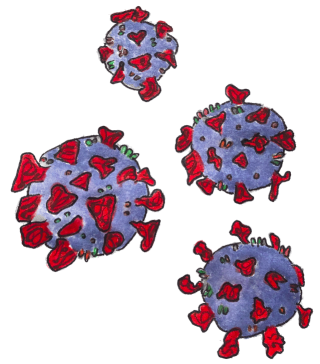Yale researchers discover that novel antiviral effectively targets numerous COVID variants
A Yale-designed RNA-based antiviral recruits the innate immune system in the body’s fight against COVID-19, indiscriminately fighting many variants of the virus and bringing new hope to immunocompromised patients.

Sarah Eisenberg
A new Yale study found that SLR14, a short double-stranded antiviral RNA molecule, can stimulate the body’s defenses and protect mice against all known variants of the COVID-19 coronavirus. The research could offer a new treatment for immunocompromised patients and provide an inexpensive antiviral to countries with limited access to vaccines.
Under the leadership of Akiko Iwasaki, professor of immunology at the Yale School of Medicine, a team of researchers discovered that an easy-to-manufacture RNA antiviral therapeutic can activate the body’s innate immune response. The innate immune response — in which interferons, a group of proteins, target universal viral markers — is the body’s first response to infection. Studies have shown that COVID-19 patients who produce high levels of interferons have better outcomes than patients who produce lower levels of interferons during the early days of infection.
“Innate immunity works across all viruses,” Iwasaki said. “It doesn’t even matter if it is an RNA or a DNA virus, as long as you initiate interferon response. Interferon response triggers thousands of genes to combat a viral infection and so it is indiscriminate of the type of virus you are dealing with and it is also very quick. Adaptive immune responses take a couple weeks to develop. This innate immune response occurs within minutes to hours.”
The scientists’ research was published on Nov. 10 in the Journal of Experimental Medicine. They found the treatment could fight a variety of COVID-19 variants infecting mice — including the Alpha, Beta, Gamma and Iota variants — as well as the Delta variant, which is currently the dominant variant in the U.S.
“In the context of continued emergence of variants, we really want an antiviral strategy that would confer broadly targeted protective immunity against a wide panel of viral variants and that is the motivation for testing SLR14 against SARS CoV-2 variants, and really to our satisfaction SLR14 was able to hold its efficacy, especially with the Delta variant which has already taken the entire world,” said Tianyang Mao ’22 GRD, a graduate student in Iwasaki’s lab and first author on the recently published paper.
As COVID-19 variants continue to mutate, the development of non-specific therapeutics is crucial, according to Iwasaki.
Additionally, current preventative treatments, such as vaccines, require the ability to form antibodies against specific COVID-19 proteins through a complex collaboration of T- and B-cells. Immunocompromised patients are unable to create sufficient levels of these cells that produce antibodies and kill viruses. The innate immune system provides an alternative treatment opportunity.
The researchers found the therapy protected mice against severe diseases and death and eradicated the virus from mice with chronic infections.
“SLR14 could potentially be beneficial in patients that are chronically infected with SARS CoV-2,” Mao said. “Mice that are chronically infected with SARS CoV-2, those that are deficient in T- and B-cells, also derive benefit from SLR14. SLR14 induces near sterilizing immunity in these mice, meaning that they completely clear the infection from their respiratory tract.”
In practice, SLR14 could also be used as a preventative measure or early post-exposure medication, according to Benjamin Goldman-Israelow, ABIM physician-scientist research pathway resident at the Yale School of Medicine and second author on the study. The antiviral therapeutic could therefore be particularly valuable for healthcare workers entering areas with a known high viral load.
By activating the interferon alarm system, SLR14 provides an early treatment method for COVID-19, enabling the body to attack the virus before it takes hold. An unusual characteristic of COVID-19 is its ability to enter the body without alerting the innate immune system; the treatment helps overcome this aspect of the virus.
“We have told the immune system, ‘Hey there’s a virus here, go after it!’” Goldman-Israelow said. “Whereas during natural infection, the virus stays silent and avoids being recognized.”
As of Nov. 11, there have been 810,327 cases of the Delta variant in the United States.







